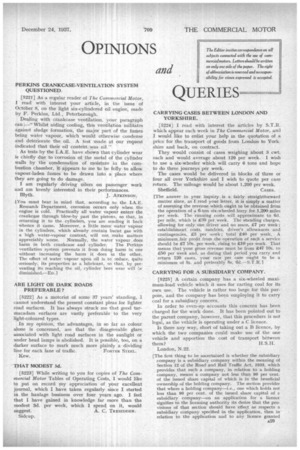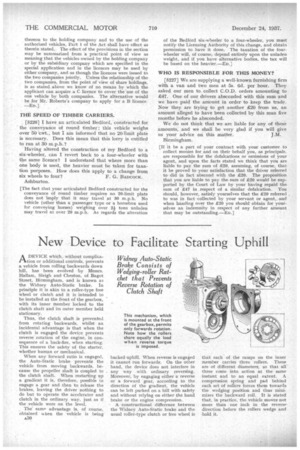OPINIONS
Page 17

Page 18

If you've noticed an error in this article please click here to report it so we can fix it.
and
QUERIES
PERKINS CRANKCASE-VENTILATION SYSTEM QUESTIONED.
[5221] As a regular reader of The Commercial Motor, I read with interest your article, in the issue of Octaber 8, on the light six-cylindered oil engine; made by F. Perkins, Ltd., Peterborough.
Dealing with Crankcase ventilation, yOur paragraph ran :—" Whilst aiding cooling, this ventilation militates against sludge formation, the major part of the fumes being water vapour, which would otherwiSe condense and deteriorate the oil. A test made at our request indicated that their oil content , was-nil."
As tests by the I.A.E. have shown that cylinder wear is chiefly due to corrosion of the metal of the cylinder walls by the condensation of moisture in the combustion chamber, it appears to me to be folly to allow vapour-laden fumes to be drawn into a place where they are going to do damage.
I am regularly driving oilers on passenger work and am keenly interested in their performances.
Blyth. J. ATKINSON.
[YOU must bear in mind that, according to the Research Department, corrosion occurs only when the engine is cold. Practically all water vapour enters the crankcase through blow-by past the pistons, so that, in returning it to the cylinders, you are sending it hack whence it came. Moreover, a little more water vapour in the cylinders, which already contain burnt gas with a high water-vapour content, will not make matters appreciably worse, Normally, the water vapour does
harm in both crankcase and cylinder. The Perkins ventilation system prevents it from doing harm in one without increasing the harm it does in the other. The effect of Water vapour upon oil is to reduce, quite seriously, its properties as a lubricant, so that, by preventing its reaching the oil, cylinder bore wear will lie diminished,—ED.1 ARE LIGHT OR DARK ROADS PREFERABLE?
[5222] As a naotcrist of some 37 years' standing, I cannot understand the present constant pleas for lighter road surfaces. It has always struck nm that good tarmacadam surfaces are vastly preferable to the very light-coloured types.
In my opinion, the advantages, in so far as colour alone is concerned, are that the disagreeable glare associated with light road surfaces in the sunlight or under head lamps is abolished. It is possible, too, on a darker surface to mark much more plainly a dividing line for each lane of traffic. FOSTER STEEL. Kew.
THAT MODEST 3d.
[5223] While writing to you for copies of The Commercial Motor Tables of Operating Costs, I would like to put on record my appreciation of your excellent journal, which I have taken regularly since I started in the haulage business over four years ago. I feel that I have gained in knowledge far more than the modest 3d. per week, which I spend on it, would
suggest. A. C. TRESIDDER. Sidcup. CARRYING CASES BETWEEN LONDON AND YORKSHIRE,
[5224] I read with interest the articles by S.T.R. which appear each week in The Cotrantereial Motor, and I would like to enlist your help in the quotation of a price for the tranSport of goods from London to York. shire and hack, on contract.
They would consist of cases weighing about 3 cwt. each and would average about 120 per week. I wish to use a six-wheeler which will carry 6 tons and hope to do three journeys per week.
The cases would " be delivered in blocks of three or four all over Yorkshire and I wish to quote per case return. The mileage would he about 1,200 per week.
Sheffield. CASES.
[The answer to your inquiry is a. fairly straightforward matter since, as I read your letter., it is simply amatter of assessing the revenue which ought to be obtained from the operation of a 6-ton six.-.wbeeled lorry for 1_,290,miles per week: The running costs will approximate to ed. per mile, which is £30 per -week. The standing charges, allowing for only else driver and no mate, £7 per Week ; estahlishinent. costs, sundries, driver's allowances and contingencies, £3 per week ; total £40 per week. A minimum., fair profit from the operation of such a service should be £7 10s. per week, rising to £10 per week. That means that 'your gross revenue must be from £47 10s, to £50 per week and, as during that period you carry and 'return 120 cases, yourrate per case ought to be a minimum of 8s. and preferably 8s. 6d.—S.T.R.1
CARRYING FOR A SUBSIDIARY COMPANY.
[5225] A certain company has a six-wheeled maximum-load: vehicle which it uses for carting coal for its own use. The vehicle is rather too large for this purpose, and the company has been employing it to carry coal for a subsidiary concern.
In order to even-up accounts this concern has been charged for the work done. It has been pointed out to the parent company, however, that this procedure is not legal, as the vehicle is operating under a C licence.
Is there any way, short of taking out a B licence, by which the two companies could make use Of the one vehicle and apportion the cost of transport between them? • H.S.H. London, N.22,
[The first thing to be ascertained is whether the subsidiary company is a subsidiary company within the meaning of Section 12 of the Road and Rail Traffic Act, 1953, which provides that such a company, in relation to a holding company, means a company not less than 99 per cent. of the issued share capital of which is hi the beneficial ownership of the holding company. The section provides that where a holding company—i.e., one which holds noi less than 90 per cent, of the issued share capital of a subsidiary company—on an application for a licencf signifies to the licensing authority its desire that the provisions of that section should have effect as respects a subsidiary company specified in the application, then in relation to the application and to any licence granted thereon to the holding company and to the use of the authorized vehicles. Part 1 of the Act shall have effect as therein stated. The effect of the provisions in the section may be summarized from a practical point of view as meaning that the vehicles owned by the holding company or by the subsidiary company which are specified in the special application and in the licences may be used by either company, and as though the licences were issued to the two companies jointly. Unless the relationship of the two companies, from the point of view of share holdings, is as stated above we know of no means by which the applicant can acquire a C licence to cover the use of the one vehicle by both companies. The alternative would be for Mr. Roberts's company to apply for a B licence. —ED.]
THE SPEED OF TIMBER CARRIERS.
[5226] I have an articulated Bedford, constructed for the conveyance of round timber ; this vehicle weighs over 50 cwt., but I am informed that no 20-limit plate is necessary. Does this mean that this lorry is entitled to run at 30 rn.p.h.?
Haying altered the construction of my Bedford to a six-wheeler, can I revert back to a four-wheeler with the same licence? I understand that where more than one body is used, the heavier must be taken for taxation purposes. How does this apply to a change from
six wheels to four? F. G. BADCOCK. Ashburton.
[The fact that your articulated Bedford constructed for the conveyance of round timber requires no 20-limit plate does not Imply that it may travel At 30 m.p.h. No vehicle (other than a passenger type or a horsebox used for conveying horses) weighing over 21 tons unladen may travel at over 20 m.p.h. As regards the alteration of the Bedford six-wheeler to a four-wheeler, you must notify-the Licensing Authority of this change, and obtain permission to have it done. The taxation of the fourwheeler will, of course, depend entirely upon the unladen weight, and if you have alternative bodies, the tax will be based on the heavier.—En.]
WHO IS RESPONSIBLE FOR THIS MONEY?
[5227] We are supplying a well-known furnishing firm with a van and two men at 5s. 6d. per hour. They asked our men to. collect C.O.D. orders amounting to 447. One of our drivers absconded with this sum and we have paid the amount in order to keep the trade. Now they are frying to get another 420 from us, an amount alleged to have been collected by this man five months' before he absconded.
We do not think that we are liable for any of these amounts,, and we shall be very glad if you will give
us your advice on this matter. J.M. Birmingham.
[If it be a part of your contract with your customer to collect monies for and on their behalf you, as principals, are responsible for the defalcations or omissions of your agent, and upon the facts stated we think that you are liable to pay the sum of 220, assuming, of course, that• it be proved to your satisfaction that the driver referred to did in fact abscond with the 220. The proposition that you are liable to pay the sum of 220 would be supported by the Court of Law by your having repaid the sum of 247 in respect of a similar defalcation. You should, however, satisfy yourselves that the £20 referred to was in fact 'collected by your servant or agent, and when handing over the 220 you should' obtain for yourselves an indemnity in respect of any further amount that may be outstanding.—En.]


























